15 highlights from Heimtextil: spot the textile trends for 2025
We were at textile trade fair Heimtextil 2025 in Frankfurt last week – here are the trendsetters and names to know among innovative launches, from health-boosting lava fabric to sheets made of milk
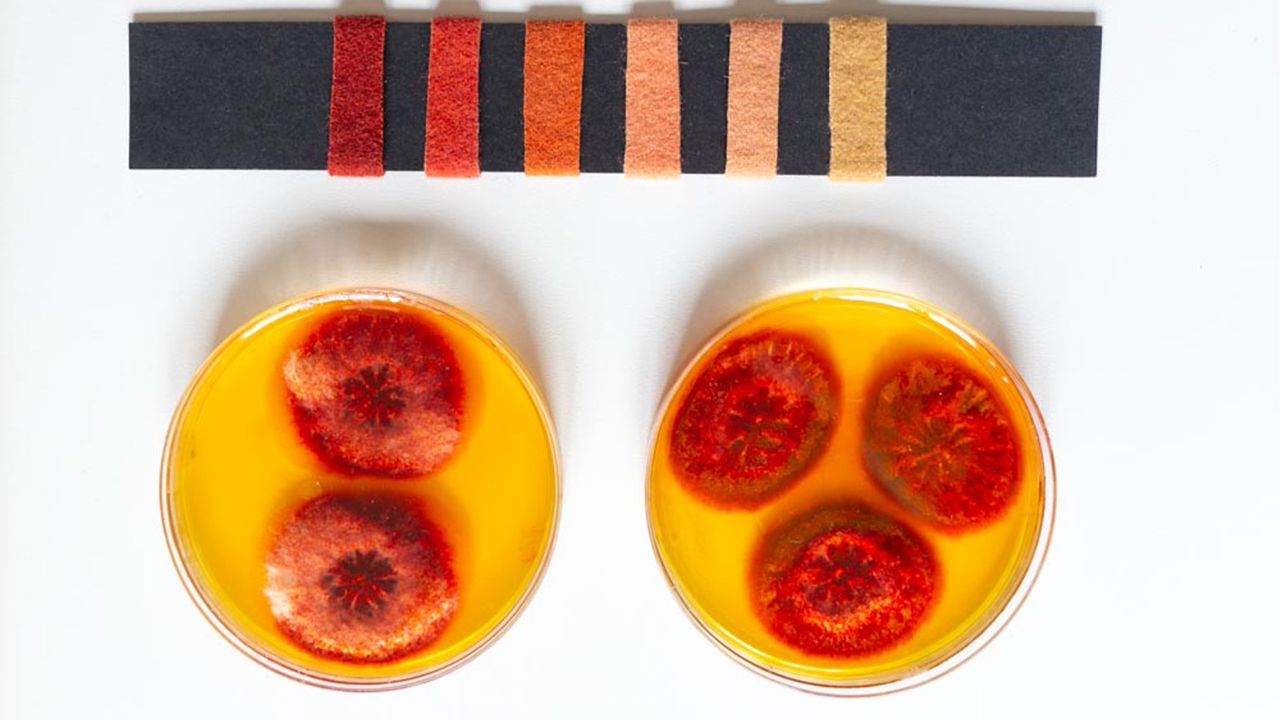
Certain fairs have the task of untangling the strings of the present so that we can read future threads. This is literally the task of Heimtextil, the largest international trade fair for home and contract textiles, the 2025 iteration of which we attended last week (14-17 January) in Frankfurt, Germany.
The vast Messe Frankfurt fairgrounds showcased halls of yarns, fabrics, and prints – with designer Patricia Urquiola as a very special and long-awaited guest. ‘Heimtextil is growing and this year welcomes over 3,000 exhibitors and participants from 130 countries. Patricia Urquiola has created an installation here that brings us closer to textile design in a unique way. Visitors experience with all senses how state-of-the-art materials, AI, digital printing techniques, and recycled fabrics come together,’ said Detlef Braun, member of the Executive Board of Messe Frankfurt.
After weaving our way through Heimtextil’s fairgrounds, and walking miles in the process, Wallpaper* reports on the highlights, which offer insight into where the textile industry is heading in 2025.
Heimtextil 2025 highlights
Patricia Urquiola
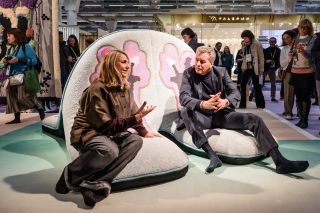
Patricia Urquiola at Heimtextil
‘Shoes off!’ Patricia Urquiola exclaimed. At Heimtextil, she showcased ‘among-us’, an open and welcoming installation that began with a grid on the floor. However, to enter the heart of the installation, which looked like a sculpture park, you were asked to remove your shoes, and walk on a soft surface, which brought relief after long hours of walking on the fair floor.
‘I wanted to create a two-layered space, with digital and physical elements,’ said Urquiola. The sensory invitation included rational modular sofas from Kettal with soft Kvadrat wool in light purple, and four tapestries by CC-tapis created with an innovative robo-tufting machine. The latter appeared almost transparent thanks to Econyl, an innovative yarn made from nylon waste. Next to them was a hanging structure of panels, made of mineral aggregates mixed with a new-generation cementing binder called Cimento. All around were ‘massive creatures’, as she described them, by Moroso – each incorporating a fabric produced using innovative water-based printing methods that reduce both water consumption and greenhouse gas emissions. Other CC-tapis carpets were developed using the traditional dhurrie technique.
‘It’s an intuitive work, we worked a lot on colours, on materials – using a printing material was a first time for me. In your creative work you need to break boundaries and get fluid,’ said Urquiola.
Alcova
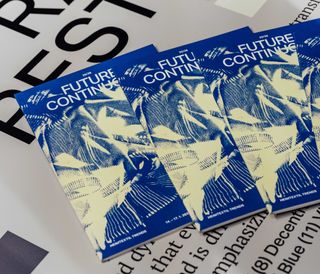
Milanese design platform Alcova provided a glimpse into the future of textiles
Curated by the Milanese design platform Alcova, this year's Heimtextil Trends 25/26 show – part of the wider fair – had the theme ‘Future Continuous’ and provided a glimpse into the future of textiles. On a long table, one after the other, three sectors emerged, each containing a variety of fabrics from the exhibitors on display: 'Regenerative' explored biodegradable fabrics and new ways to reconsider the life span of a material; 'Radically Restructured' looked at digital weaving and techniques that can mimic the unpredictable nature of natural production; and 'Naturally Uneven' celebrated the imperfection of natural materials.
Wallpaper* Newsletter
Receive our daily digest of inspiration, escapism and design stories from around the world direct to your inbox.
Lanerossi
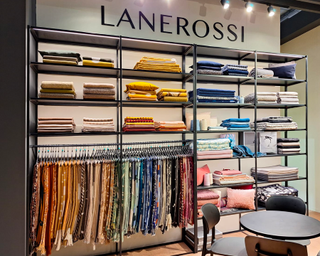
Lanerossi's ‘Lavabili’ material
Have you never understood how to wash cashmere, or are you perhaps concerned about the environmental impact of dry cleaning? This is when Lanerossi steps in, presenting ‘Lavabili’, its machine washable plaids and blankets made of 100 per cent cashmere and 100 per cent wool, which can be washed at home in the washing machine. The products are certified Global Organic Textile Standard, an international standard for clothing and fabrics made from natural fibres sourced from organic farms.
Lavatech
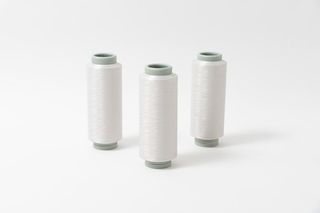
A new polyester generated by finely blended Mount Fuji lava powder
Among our discoveries at the fair, Yagi & Co's new material containing high-quality underground lava rock deserves a special mention. It's called Lavatech, and as the name implies, it's made by finely crushing lava rock found in the ground around Mount Fuji before weaving it into fibres. According to the brand, it has a strong far-infrared effect (far-infrared radiation being the kind of electromagnetic waves that deliver thermal effects, promoting blood circulation), and so will enable the development of new products to address a range of health and wellbeing issues, spanning sleep, sports and beauty.
Wellbeing
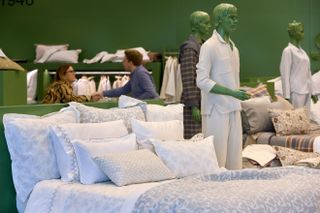
Lameirinho presented pyjamas intended to promote peace between couples with different temperature regulation issues
According to Beddinghouse, skincare begins in the bedroom. The bed and bath linen company launched a skincare pillowcase with collagen fibres that work while you sleep, ensuring (the brand says) long-term benefits even after multiple washes. A sheet designed for athletes, or active people in general, is also interesting – it's designed to boost circulation and support muscle recovery, allowing you to wake up feeling revitalised.
Bedding and home textile brand Lameirinho, meanwhile, presented pyjamas designed to help regulate temperature – so no more duvet wars for couples with different temperature requirements. The pyjama textile uses ‘advanced chemical inducers’ that engage with the skin on a deeper level – so the warming sensation is more than just a feeling, it enhances blood flow.
Digital

MYTH AI demonstrated the role of generative AI technology for the design of bedding, wall décor, home textiles, and flooring
At Heimtextil, digital technology, particularly artificial intelligence, was given special attention. Kornit Digital specialises in on-demand digital fashion and textile production technologies; here, it demonstrated the surprising result of pigment printing done in such a way that the texture is built up, resulting in an intriguing 3D effect. The company debuted a furniture collection in collaboration with Niso Furniture, featuring sofas, armchairs, a dining table, and curtains.
MYTH AI, meanwhile, demonstrated the role of generative AI technology for the design of bedding, wall décor, home textiles, and flooring. The company explained that using advanced AI makes the design process faster, more customisable, and less expensive. It also provides design security through blockchain certification and IP protection.
Isidore Bryant
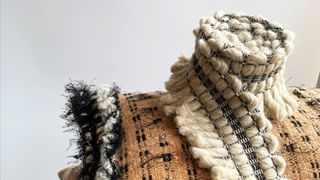
Isidore Bryant, a textile design studio founded in 2023 by weaver Elizabeth Ballon, is named after her paternal grandfather and maternal great-grandmother
Natural materials undoubtedly played a role at Heimtextile 2025. Their value goes far beyond the fact that a certain irregularity increases the life of a textile (no one would notice a new flaw in a beautifully imperfect piece). But for an example of quirky natural beauty, take Isidore Bryant, a textile design studio founded in 2023 by trained weaver Elizabeth Ballon (and named after her paternal grandfather and maternal great-grandmother). Ballon loves silk, wool, cashmere, cotton, and linen, and she uses two restored vintage looms (as well as computer-generated drafts) to produce tactile textile collections whose appeal is sure to endure.
Libeco
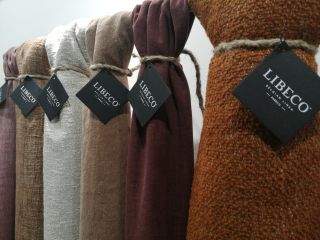
Working with certain natural yarns is comparable to producing wine, according to Libeco, Belgium's largest flax weaving mill and one of Europe's leading linen manufacturers. Climate and soil have an impact on production, especially when it is local and sustainable, as in Libeco’s case. Because its products are completely natural, it explains, they can be buried at the end of their life cycle – from nature to nature. Among other pieces, we loved the new ‘Q581 changeant Laundered’, a bulky textured linen-wool blend with such a soft feel.
Young talents
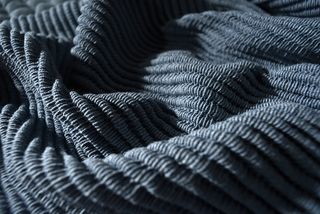
Kateryna Basiuk investigates how recycled yarns function in aesthetically appealing acoustic absorbers, inspired by structures within moths' wings
Among the young winners of the Heimtextil University Contest 2025, we were amazed by Birke-Katharina Weber's research project, MycoColors. It explores the potential of mushrooms as a sustainable source of textile dyes, to replace synthetic colours. Colourants are extracted from the fruiting bodies of existing fungal species and mycelia can be grown in bioreactors under controlled conditions. ‘The goal is to create a constantly expanding palette of colours that can also be applied to other materials,’ says Weber.
Equally brilliant is Silent Canvas, a project by Kateryna Basiuk from Lucerne School of Design, Film and Art. Basiuk investigates how recycled yarns function when used in aesthetically appealing and effectively cushioned circular acoustic absorbers. The concept stems from the ultrasonic-absorbing microstructures of moth wings, which can block predator noise, and whose natural structures are replicated and knitted in recycled materials.
The Rug Republic
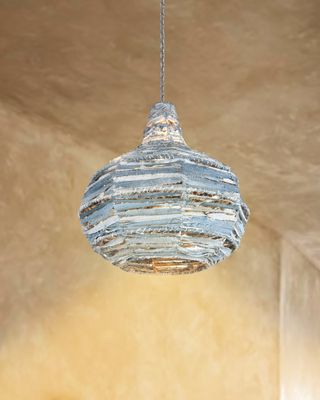
‘Argo Denim’ lamp
This year, Indian brand The Rug Republic launched a new artisanal lighting collection – a selection of decorative lamps made from natural materials. One of the most innovative, and successful, is the ‘Argo Denim’ lamp, as upcycled denim is a symbol of circular supply chains. The company explains that waste denim from around the world is imported into India, stripped of its metals, and the remaining fabric is used to make rugs, pouffes, and lamps.
Edmund Bell
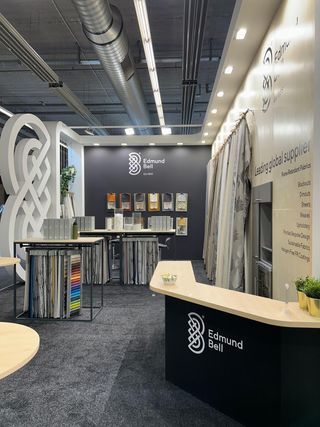
Eureka! Fairs like Heimtextil allow you to discover small and less-known innovations that are often overlooked by laypeople. According to Edmund Bell, a global leader in high-performance fabrics, the concept of a double-sided textured blackout fabric was difficult to obtain for those working in the field due to some technical constraints. At the fair, the company provided an exclusive preview of its solution, called Diversity, which it claims will set a new standard in textured blackout curtains.
Salgado Group
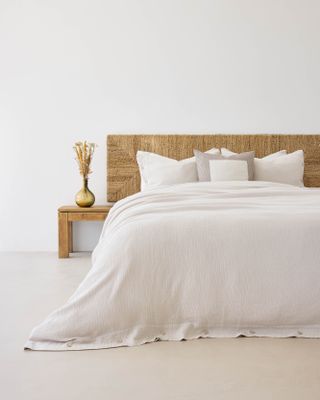
Salgado Group made headlines at Heimtextil, presenting sheets made using the extracted proteins from milk and soya beans, pineapple leaves, and nettle plant stalks
A pillowcase out of milk? When it comes to innovative fibres, Portugal's Salgado Group made headlines at Heimtextil 2025, presenting, among other things, sheets made using the extracted proteins from milk and soya beans, pineapple leaves, and nettle plant stalks. Other sheets contain waste carpet mixed with sustainably sourced wood pulp derived from fast-growing, responsibly managed forests. All, of course, are cotton-blend.
Wall coverings
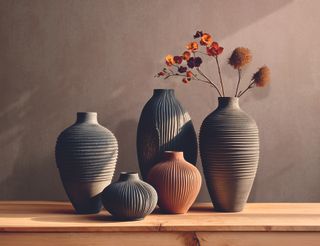
Marburger Tapetenfabrik introduced Terra, its first clay-based wallpaper collection
The Marburger Tapetenfabrik, one of Europe's oldest and most prestigious wallpaper factories, introduced Terra, its first clay-based wallpaper collection. Screen and intaglio printing techniques are used to create its designs, which feature unique clay-based colours sourced locally. As a result, it is plasticiser-free. There has been a lot of interest in the brand's Celsius collection, too, which is a wallpaper that reflects heat rays thanks to aluminum pigments on the surface.
On another note, K'moor presented Cemento – an odd name for environmentally friendly wallpaper – made from an innovative biomass compound. Another option is Flax, which is derived from flax-plant fibres and is completely compostable.
Animal friendly
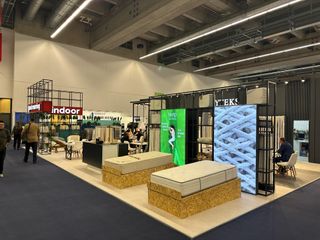
Boyteks, from Turkey, exports its mattress fabrics to over 100 countries each year
Attention to animals has made its way into the textile industry in unexpected and intriguing ways. Boyteks, from Turkey, exports its mattress fabrics to over 100 countries each year. This means it is among the first to respond to new trends and needs, and it now has a line of vegan products that, according to the brand, avoid any process that would harm animals at any stage of manufacturing. Its vegan mattress fabric, a success at Heimtextil, is entirely made from plant-based materials.
Another surprise, from Elastron, a well-known supplier for the upholstery industry, was its ‘Chanel’ collection, inspired by the fashion house and produced by the brand Magenta. The specially developed velvet does not tear or scratch easily, and is easier to clean than traditional velvet.
Rug trends
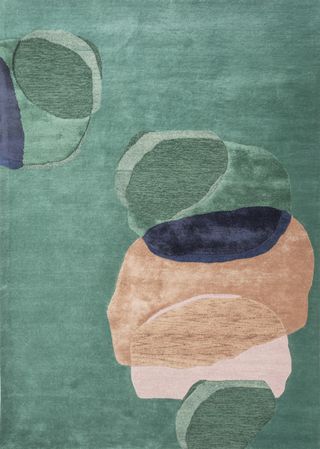
'Antique Green Hawaiian Sunset' rug by Jaipur Rugs
An interesting talk, ‘Crafting tomorrow: Key trends shaping the rug industry’, came from Lucy Upward of Cover magazine, which is dedicated to handmade carpets and textiles for interiors. The trends she touched on spanned from the authenticity of storytelling to the prevalence of dark and warm neutral colours, and the ‘Unexpected Red Theory’, a TikTok trend suggesting that adding a pop of red to a room can make the space feel more interesting and cohesive. And of course, there were AI-designed rugs. Some examples? The 3D textures of Merinos, the layering of Jaipur Rugs, and the use of abstract patterns at Oriental Weavers.
Cristina Kiran Piotti is an Italian-Indian freelance journalist. After completing her studies in journalism in Milan, she pursued a master's degree in the economic relations between Italy and India at the Ca' Foscari Challenge School in Venice. She splits her time between Milan and Mumbai and, since 2008, she has concentrated her work mostly on design, current affairs, and culture stories, often drawing on her enduring passion for geopolitics. She writes for several publications in both English and Italian, and she is a consultant for communication firms and publishing houses.
-
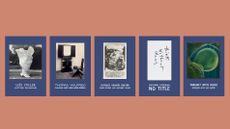 The Further Reading Library is a new collection of esoteric art and design books
The Further Reading Library is a new collection of esoteric art and design booksCollating the forgotten histories of left-field creatives, this new publishing imprint reveals hitherto unseen artistic experiments from the past
By Jonathan Bell Published
-
 Ai Weiwei's major retrospective in Seattle is a timely and provocative exploration of human rights
Ai Weiwei's major retrospective in Seattle is a timely and provocative exploration of human rights'Ai, Rebel: The Art and Activism' of Ai Weiwei is on now at the Seattle Art Museum
By Hadani Ditmars Published
-
 The memento mori art inspiring Japanese Breakfast's new album
The memento mori art inspiring Japanese Breakfast's new albumSinger Michelle Zauner of Japanese Breakfast is inspired by 17th-century Dutch vanitas works for her new album cover
By Rachel Cabitt Published
-
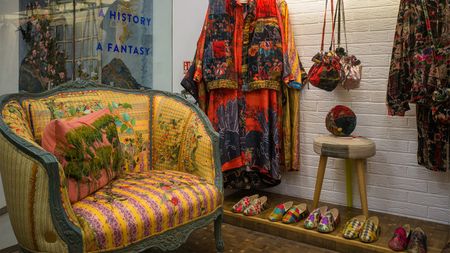 This Beirut design collective threads untold stories into upholstered antique furniture
This Beirut design collective threads untold stories into upholstered antique furnitureBeirut-based Bokja opens a Notting Hill pop-up that's a temple to textiles, from upholstered furniture to embroidered cushions crafted by artisans (until 25 March 2025)
By Tianna Williams Published
-
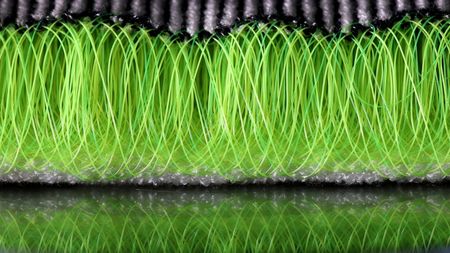 Is Emeco's 'No Foam KNIT' a sustainable answer to synthetic upholstery textiles?
Is Emeco's 'No Foam KNIT' a sustainable answer to synthetic upholstery textiles?'Make more with less' is Emeco's guiding light. Now, the US furniture maker's new mono-material textile, the 'No Foam KNIT', may offer a sustainable solution to upholstery materials
By Ali Morris Published
-
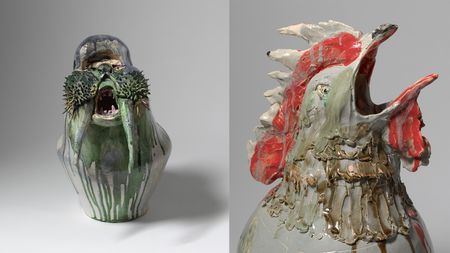 Hella Jongerius’ ‘Angry Animals’ take a humorous and poignant bite out of the climate crisis
Hella Jongerius’ ‘Angry Animals’ take a humorous and poignant bite out of the climate crisisAt Salon 94 Design in New York, Hella Jongerius presents animal ceramics, ‘Bead Tables’ and experimental ‘Textile Studies’ – three series that challenge traditional ideas about function, craft, and narrative
By Ali Morris Published
-
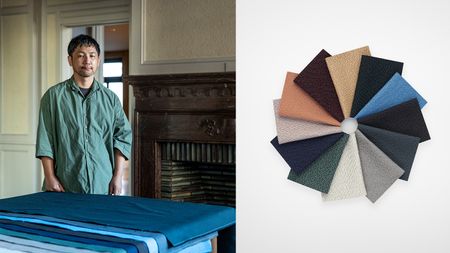 Teruhiro Yanagihara's new textile for Kvadrat boasts a rhythmic design reimagining Japanese handsewing techniques
Teruhiro Yanagihara's new textile for Kvadrat boasts a rhythmic design reimagining Japanese handsewing techniques‘Ame’ designed by Teruhiro Yanagihara for Danish brand Kvadrat is its first ‘textile-to-textile’ product, made entirely of polyester recycled from fabric waste. The Japanese designer tells us more
By Danielle Demetriou Published
-
 First look: Western Mongolia meets Kew Gardens in John Pawson and Oyuna Tserendorj’s cashmere throws
First look: Western Mongolia meets Kew Gardens in John Pawson and Oyuna Tserendorj’s cashmere throwsArchitectural designer John Pawson and cashmere designer Oyuna Tserendor have collaborated on a cashmere throw collection inspired by Pawson’s 70m Lake Crossing in the Royal Botanical Gardens
By Scarlett Conlon Published
-
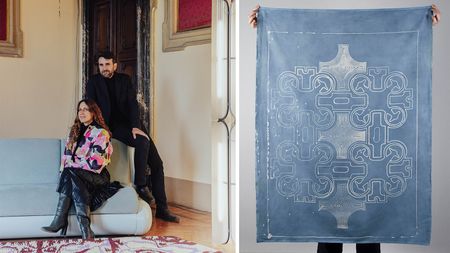 Alcova to curate Heimtextil Trends 25/26: expect ‘inspiration and surprise’
Alcova to curate Heimtextil Trends 25/26: expect ‘inspiration and surprise’German textile fair Heimtextil has launched a new collaboration with Alcova, the experimental design platform. Here’s what to expect from the January 2025 fair
By Cristina Kiran Piotti Published
-
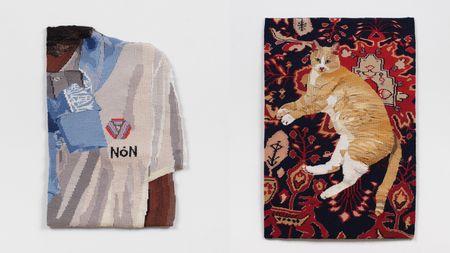 Sportswear logos, intimate portraits and a curled-up cat: Elizabeth Radcliffe’s beguiling tapestries go on show in New York
Sportswear logos, intimate portraits and a curled-up cat: Elizabeth Radcliffe’s beguiling tapestries go on show in New YorkAt Scottish artist Elizabeth Radcliffe's first US exhibition, a series exploring identity through branding is among works at Tribeca gallery Margot Samel
By Dan Howarth Published
-
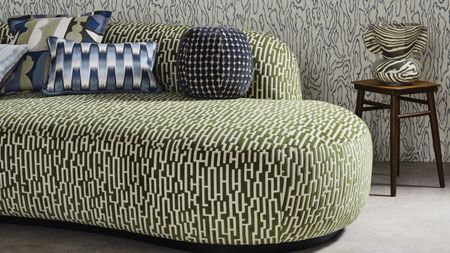 First look: clay meets paper and textiles in Henry Holland's new collection for Harlequin
First look: clay meets paper and textiles in Henry Holland's new collection for HarlequinHenry Holland, the fashion designer-turned-ceramicist, has teamed up with Harlequin for a range of playful, tactile wallpapers and textiles
By Hugo Macdonald Published